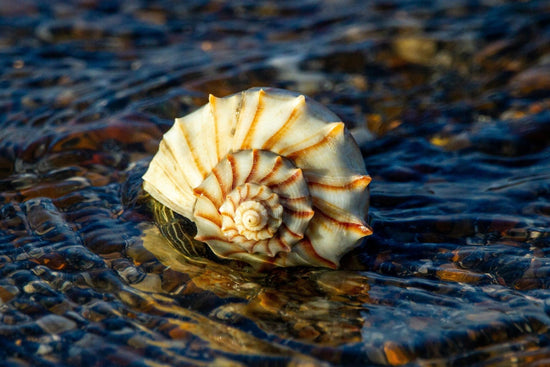It’s more than just touching grass: If you’re looking for an easy, effective, and free way to calm your mind, manage stress, and feel more connected to your body, look no further than grounding. These meditative techniques are designed to bring us into the present moment and create more ease in our bodies. While some exercises are more complex than others, it really can be as simple as meditating for five minutes or getting outside and, yes, touching grass!
If you’re getting curious about grounding, the potential benefits of connecting with the Earth, or even deepening your magical practice, we’ve got a wealth of information to explore. Take a seat upon your nearby patch of grass, take a deep breath (or two), and let’s get into it!
In this article:
Header image by Mor Shani.
What Is Grounding?

Photo by Mor Shani.
The term ‘grounding’ refers to a plethora of mindfulness practices and physical exercises geared towards calming the mind and creating a sense of connection between oneself and the Earth, the body, or the present moment. These techniques can range from calming visualizations or meditations to spending time in nature or walking barefoot on the Earth. Many folks practice grounding to regulate their nervous systems or refresh their moods.
Grounding can also be a meaningful part of a spiritual practice. Particularly in nature-based traditions like green witchcraft or modern paganism, forming a strong connection with the Earth might be an important foundation for rituals or routines. Grounding can build one’s awareness of their own body and energy as well, helping to create a feeling of inner alignment.
Grounding vs. Earthing: What’s the Difference?

Photo by Jordan Whitt.
Grounding encompasses a wide variety of psychological and physical regulation techniques. Earthing, on the other hand, is a specifically physical form of grounding focused on improving human health through bioelectrical regulation—AKA, skin-to-Earth contact.
It works like this: The Earth has a negative electric charge, which leaves an abundance of electrons at its surface. Earthing researchers suggest that interacting with the Earth’s electrons can neutralize unstable electrical energy within the human body (such as free radicals) and provide a host of health benefits for the body and mind. Achieving this is as simple as taking your shoes off and walking barefoot outside on conductive surfaces like concrete, soil, grass, or sand for just half an hour.
“We are bioelectrical beings living on an electrical planet. Our bodies operate electrically. All of our cells transmit multiple frequencies that run our heart, immune system, muscles, and nervous system. With the exception of humans living in industrialized societies, all living things on our planet are connected to the ground’s electrical energy.”
—Deepak Chopra MD, FACP, FRCP
All this being said, a larger body of research is needed to truly understand the electrical interactions between our bodies and the Earth, as well as the supposed benefits this relationship might provide. It is clear, however, that spending time outside is an important tenet of human health that does help us to feel more grounded and at ease.
So, what’s the real difference between grounding and earthing? It’s like the square that’s always a rectangle and the rectangle that’s not always a square: Earthing is always a grounding technique, but not all grounding techniques involve earthing.
Health Benefits of Grounding and Earthing
The health benefits of grounding and earthing are still being studied. Compelling yet inconclusive evidence can be found on every side of the discussion, in part due to weak study design or data analysis, and in part due to the minimal body of research done on this topic in general. So, at this point in time, it’s difficult to say for sure how connecting with the Earth truly impacts our bodies and minds.
That makes it important to note that grounding or earthing techniques should not replace other forms of self-care, therapy, and/or prescribed medication. Managing our health is not a one-stop shop, and every body requires different kinds of support. Grounding or earthing will not heal chronic pain or disease, nor will it magically restore your body to full health on its own.
As Dr. Albers, PsyD at the Cleveland Clinic in Ohio puts it: “Connecting with nature can absolutely benefit your physical and mental health. And it may be worth integrating into a holistic treatment plan for a chronic condition. But that is not the same thing as claiming earthing can prevent or cure disease.”
With all that being said, we still find it important to explore the biological relationship between humans and the natural world, and are perpetually excited to reintegrate nature into our ways of life. So, let’s review a few of the potential health benefits of grounding or earthing.

Photo by Nikola Murniece.
Improved sleep. Grounding or earthing the body is shown to have a measurable impact on the body’s cortisol levels, a hormone that helps to regulate the sleep-wake cycle. This study found that participants previously complaining of stress, pain, or sleep dysfunction reported reduced or eliminated symptoms after sleeping on a conductive earthing mattress pad for eight weeks. These changes were reflected in the rhythms and levels of cortisol production.
Decreased stress. First, a bit of context: The sympathetic nervous system (SNS) activates your body’s “fight or flight” stress response, and the parasympathetic nervous system (PSNS) causes your body to relax. Both these systems control automatic functions like digestion, sweating, heart rate, and more. Excessive sympathetic nerve activity may be connected to a wide variety of maladies, including chronic stress and anxiety.
This study found that grounding the body to the Earth seems to “shift the autonomic nervous system from sympathetic toward parasympathetic activation,” resulting in decreased feelings of stress. Additionally, participants in this study reported reduced mental and emotional stress as well as improved moods while consistently practicing grounding or earthing methods.
Reduced pain and inflammation. This study found that allowing the body to absorb electrons from the Earth’s surface had a significant impact on the body’s ability to recover from injury. Not only did earthing cause inflammation symptoms (such as heat, swelling, and pain) to subside significantly—it seemed to speed the healing process as a whole. Researchers have also observed that grounding can reduce pain in patients with autoimmune disorders, such as lupus. Some are even calling grounding a “universal anti-inflammatory remedy.”
Healthier heart. According to this paper, grounding or earthing improves heart health in a number of ways. Grounding can increase circulation and blood flow, which is essential for distributing nutrients (such as oxygen), hormones, and immune cells throughout the body; decrease blood viscosity, or thickness, which is a “major factor in cardiovascular disease”; increase heart rate variability, a positive indication of the body’s adaptability to changes and new environments; and reduce soreness after exercise.
The paper also notes that, for those at cardiovascular risk, grounding can be practiced in tandem with a cardiologist’s recommended medications or therapies to support the heart.
How Often Should I Ground Myself?

Photo by Stormseeker.
How often you practice grounding techniques is entirely up to you, your schedule, and your needs. Many folks swear by a daily grounding routine, while others might enjoy a more sporadic or spontaneous session. The frequency of your practice may also fluctuate over time to support you during major life events or stretches of emotional unrest. In designing your practice, it might help to clarify what purpose grounding might serve in your life.
It is also important to note that a grounding practice does not need to be lengthy or elaborate. Even if it simply looks like a few mindful minutes at the end of your day to check in and give yourself a brief reset before bed, you’re still doing it right.
All in all, grounding is meant to help you feel a deeper sense of calm, connection, and spaciousness. As you evaluate what makes the most sense for you, consider the following questions:
- Why do I feel interested in grounding myself more often?
- Which grounding techniques do I feel drawn to? (Earthing, mindfulness exercises, et cetera)
- How connected do I feel to myself these days?
- What’s the current state of my physical and/or emotional wellbeing? Would experimenting with grounding techniques support how I feel?
- Is it meaningful to me to deepen my relationship with the Earth?
How to Ground: Easy Grounding Exercises

Photo by Chelsea shapouri.
There are many simple techniques for grounding ourselves in the present moment. You might experiment with guided meditations for grounding (we’re particularly fond of body scans); deep breathing exercises; sensory stimulation, such as aromatherapy (find our plants to use below), placing your hands in water, or touching different textures with your hands; journaling; going for a mindful walk; engaging your body through stretches or physical exercise; sitting or walking barefoot outside (earthing); or even simply spending time in nature.
Everybody’s grounding needs are different, so give yourself space to invent and experiment to find the exercises that work best for you. Below, we go in depth into two of our favorite mindfulness practices for grounding.
5, 4, 3, 2, 1 Method
The 5, 4, 3, 2, 1 grounding method is designed to quickly soothe anxiety and stress responses. It works by shifting awareness away from racing thoughts and drawing awareness into the body through each of the five senses. As such, this can be done at any time and in any location. Challenge yourself to move slowly through each of the senses, observing the more understated details of your environment. It goes like this:
Find five things you can see. Scan the details of your surroundings and notice anything that jumps out. Try paying attention to the colors, sizes, shapes, or textures of the objects around you.
Find four things you can feel or touch. These can be physical objects in your environment, such as a blanket, water bottle, chair, or ring; or, these might be subtler sensations, such as the heat of sunlight on your skin or the feeling of air entering and leaving your nose.
Find three things you can hear. Tune into the sounds in your environment. Try looking for quieter sounds beneath the louder noise you might notice first. If it helps you to listen to music, listen for the individual tones or rhythms that create the song.
Find two things you can smell. If you have the time and space to prepare for this exercise, you might light a soothing candle or spritz an essential oil mist that you enjoy. You might also smell the scent of your clothing, hand soap, or cup of coffee or tea.
Find one thing you can taste. You might find it helpful to suck on a mint, chew a piece of gum, or take a sip of water, coffee, or tea. Try paying attention to the full sensation of flavor. You can also simply notice any taste lingering on your tongue.
Tree Visualization
If you’re someone who enjoys visualizations, this technique might be particularly effective for you. When we think about the sensation of feeling solid, centered, and grounded, we might conjure the image of a tall tree with deep roots. Such is the subject of this visualization. You can try this while sitting, standing, or lying down. You might even like to practice this outside or on the ground, if you’re able! It goes like this:
Settle into your body by closing your eyes and taking a few deep breaths. Acknowledge that here, in this moment, it is safe to let your guard down and relax entirely.
As you continue to breathe, become aware of the Earth beneath you. Slowly, breath by breath, start to imagine roots extending down your legs and into the soil below. (Note: These roots can always find their way into the Earth, even if you’re meditating thirty floors off the ground.)
These roots can travel as deeply as you’d like; perhaps they might wrap around the core of the Earth itself.
Following your breath, let your awareness travel back up to you. As you enter your body again from below the surface of the Earth, allow your tree to lengthen through your core and up your spine, forming a strong, sturdy trunk.
Growing ever skyward through your arms and the crown of your head, find your tree sprouting branches and breathing in sunlight.
When the image of your tree has filled out completely, sit within it for a few moments and notice how you feel. Allow your breath to travel through your core, down to the tips of your roots, and up through your crown again. Feel that your tree is firmly planted in the Earth below, swaying gently in the wind above.
When you’re ready, gently open your eyes again. If you’d like, you can set an intention to carry this image with you through your day, knowing it is available to tune into at any time with just a few conscious breaths.
How to Use Grounding in Witchcraft

Photo by Akira Eshi.
As witches, grounding can be an extremely useful exercise that serves many purposes. Like meditation, grounding can allow you to practice focusing your energy toward a specific intention or goal. It can help you to center your mind, body, and energy before and after performing rituals. Grounding can also facilitate your drawing power from the Earth to charge your magical workings, intentions, or materials—something that may be especially useful for green witches.
Keep reading to find our recommended herbs and crystals to use for grounding.
What is Grounding, Centering, and Shielding?
In the world of witchcraft and energy work, you might encounter discussion on the triad of grounding, centering, and shielding. While definitions of each of these practices might vary from witch to witch, we can generally think of it like this:
Grounding is about presence. This connects you to your body and roots you into the Earth, creating a sensation of security and strength.
Centering is about alignment. This attunes your mind, body, heart, and spirit to one another, creating a sensation of harmony and awareness.
Shielding is about protection. This casts a selectively permeable boundary around your energy, creating a sensation of refuge and clarity within your sphere.
Each of these techniques emphasizes the importance of building awareness of your own energy, as well as the energy at play in the world around you. As a witch or energy worker, you might interact with or draw power from a variety of sources in your practice. Grounding, centering, and shielding ensure your sense of self doesn’t get lost in the mix.
Becoming familiar with your own power and voice can sharpen your intuition and discernment, particularly when it comes to communing or working with different spirits or deities. Travel safely through metaphysical realms with a well-established base within yourself to come home to.
Best Herbs for Grounding
Below, find a list of some of our favorite botanicals to support our grounding rituals, or simply to help imbue a grounding energy into our spaces. You can work with these plants by burning them as essential oil incense or candles; brewing them into tea (making sure you’re using edible plants); wearing them as solid perfumes or in an amulet or aromatherapy necklace; diffusing or spraying them throughout your space; incorporating them into magical workings; et cetera.
As each plant carries its own unique host of metaphysical correspondences, we’ve also included a few of the plants’ other properties in this list, as well as where to find them among our 100% pure essential oil blends.
Are you a budding green witch or interested in learning more about how to call on the power of plants in your magical practice? You might find our beginner’s guide to green witchcraft a most compelling read.

Photo by Jana Ohajdova.
Benzoin for purification, meditation, and emotional upliftment. Find benzoin featured in our Yule and Ostara essential oil blends.
Frankincense for cleansing, purification, protection, and ancestral work. Find frankincense featured in our Goldberry and Gibbous Deodorant essential oil blends.
Lavender for soothing anxiety, calming nerves, and creating peace. Find lavender featured in our Herbal Renewal and Beltane essential oil blends.
Patchouli for prosperity, fertility, and connecting with the Earth. Find patchouli featured in our Hermitage and Fae Ring essential oil blends.
Peppermint for mental relief, cleansing, purification, and renewal. Find peppermint featured in our Hummingbird and Krampus essential oil blends.
Pines and conifers such as pine, cedar, fir, spruce, and juniper for protection, relaxation, intuition, and cleansing. Find cedar and fir featured in our White Lodge and Timberwolf essential oil blends.
Rosemary for mental sharpness, cleansing, and protection. Find rosemary featured in our Samhain and Night Nymph essential oil blends.
Garden sage for emotional strength, healing, and wisdom. Be sure to use garden sage rather than the endangered white sage plant that is sacred to Indigenous spiritual traditions.
Sandalwood for meditation, purification, and managing anxiety. Find sandalwood featured in our Lammas and Imbolc essential oil blends.
Sea salt for purification, protection, and absorbing intentions. Sea salt may not be an herb, but is useful in grounding as a direct material of the earth.
Vetiver for focus, mental clarity, inner wisdom, and meditation. Find vetiver featured in our Litha summer solstice essential oil blend.
Best Crystals for Grounding

Photo by Sarah Brown.
If you’re a burgeoning green witch or simply enjoy incorporating elements of nature into your practice, you might be interested in working with crystals. Many folks today enjoy using crystals to activate, carry, or support specific intentions or goals based on their metaphysical properties. Some prefer a stone that can be held or placed on an altar, yet many also wear these talismans as necklaces, bracelets, rings, or other jewelry for a bit of magic they can tap into wherever they are.
Even if you don’t believe that crystals innately carry magical properties, crystals can still be useful for grounding techniques. In meditation, holding a crystal can give racing thoughts an anchor to focus on as the mind settles. Crystals can also provide engaging sensory stimulation that can help to bring attention into the present moment.
If you would like to incorporate crystals into your practice, it is extremely important that you source your stones ethically. As written by Eva Wiseman for the Guardian: “There are issues around sustainability: crystals are a non-renewable resource. There are issues around labour: most jobs are low paid, unsafe, and sometimes performed by underage workers. And there is an issue around accountability: the industry is unregulated, allowing exploitation to go unchecked.”
However, ethically sourced crystals do exist. Before you purchase crystals, check your seller’s transparency policy. Is it clear where the stones come from, and who pulled them from the Earth? If not, ask for clarity, or consider taking your business elsewhere. You might also look for second-hand or upcycled stones that are ready for a new home. It is critical to be mindful of our environmental impact if we are to make self-care decisions as sustainably as possible. In this realm, we live by the motto that less is more.
With all of this being said, below is our assortment of recommended crystals to use for grounding. Each stone is listed with a few of its other metaphysical properties to provide a fuller flavor profile!

Photo by Content Pixie.
Moss agate for stability, tranquility, self-expression, abundance, emotional balance, and releasing fear
Bloodstone for intuition, creativity, protection, courage, mental clarity, and dispelling negativity
Garnet for energy, vitality, protection, sexuality, love, spiritual fortification, and self-confidence
Hematite for protection, strength, focus, harmony, and transforming unwanted habits
Red jasper for stimulation, endurance, relaxation, emotional relief, and strengthening boundaries
Jet for protection, purification, meditation, healing, overcoming fear, and absorbing negativity
Black obsidian, mahogany obsidian, or snowflake obsidian for protection, emotional support, vitality, inner power, and growth
Black onyx for protection, stress relief, strength, self-confidence, healing, and wisdom
Smoky quartz for processing heavy emotions, alleviating fears, and manifesting dreams or desires
Shungite for protection, emotional balance, stress relief, mental clarity, and purification
Tiger’s eye for intuition, inner fire, protection, self-worth, motivation, and unblocking creativity
Black tourmaline for protection, purification, positivity, cleansing, inspiration, and compassion
* * *
What role does grounding play in your life? Feel free to share your favorite tips or grounding exercises in the comments below!





